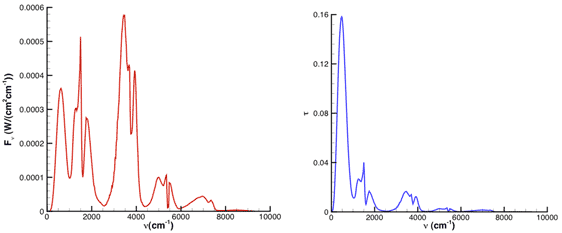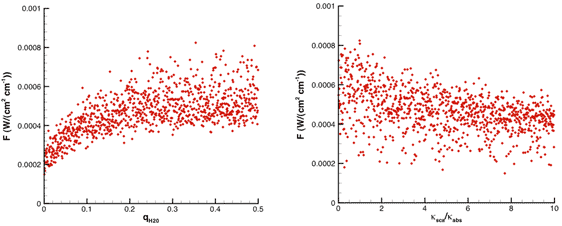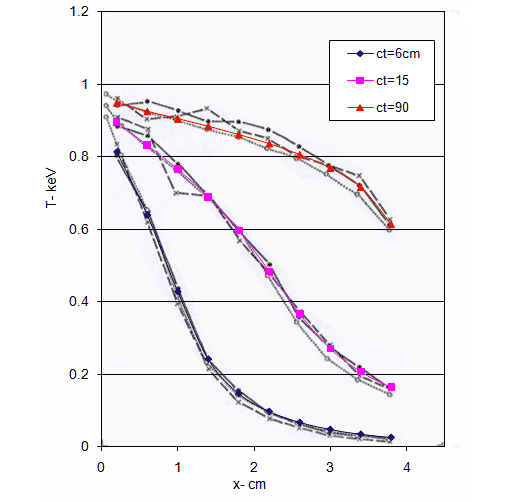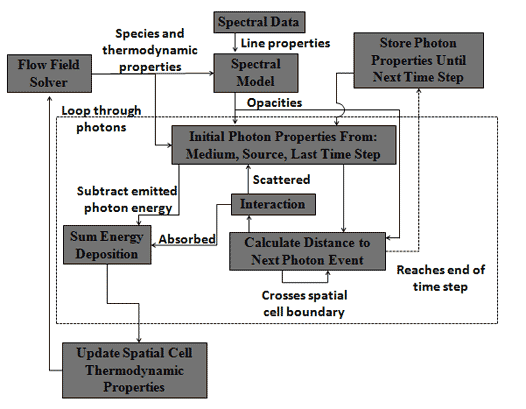| The combustion processes in a hydrogen-fueled scramjet generate significant heat release leading to high gas temperatures, thermal radiation emission, and significant heat loads on the walls of the combustor chamber and nozzle of the engine. The wall temperatures may play an important role in the combustion processes and the wall heat fluxes need to be characterized accurately in order to assess thermal protection requirements for the scramjet engine. The objective of the Thermal Management Modeling task is to analyze the thermal conditions of the scramjet engine walls accounting for the physical processes of convection and radiation from the hot gas, and conduction into the solid walls. The uncertainties in all of these processes must be communicated throughout the analysis to quantify the uncertainties in engine wall temperatures. |
| |
| |
| Approach |
| The convective heat fluxes generated in the flow through the combustor and nozzle of the scramjet engine are being predicted as part of the Heat Release Modeling activity. In addition to these convective heat fluxes, the flow field results (temperature, pressure, species mole fractions) from the Heat Release Modeling are used as input conditions to determine the radiative heat fluxes to the engine walls. |
| |
| Radiation transport is being modeled using two different approaches. An Implicit Monte Carlo (IMC) method provides a relatively high level of physical accuracy at relatively large numerical expense. A Discrete Ordinates Method (DOM) provides a lower fidelity approach with a higher computational efficiency. In these analyses, both IMC and DOM use the same spectral model in which the primary thermal radiators are water and the hydroxyl radical. Comparison between the IMC and DOM results will form part of the uncertainty analysis of the Thermal Management Modeling. |
| |
| Since the DOM solves the equations of radiation transport, it lends itself well to an adjoint sensitivity analysis. Such an analysis is being performed to aid in the study of how uncertainties in the Heat Release Modeling are transmitted into uncertainties in the radiative heat flux results. |
| |
| |
| Results |
| The DOM can currently test 1D traces of the scramjet interior. Shown in Fig. 1 below are the wall heat fluxes and optical depths for a trace across the exit plane of the Hyshot combustion chamber. The height of the chamber is 9.4mm with average temperature, pressure, H2O mass fraction and OH mass fraction of 2100K, 214kPa, 0.16, and 0.009, respectively. |

Figure 1: Wall heat flux (left) and optical depth (right) as a function of wavenumber.
|
| |
| The DOM code can be used to run multiple test cases quickly. In Fig. 2(left) a monochromatic test case is run with varied parameters comparing the H2O mixing ratio in a combustion chamber to the overall heat flux. In Fig. 2 (right) a monochromatic test case is run with varied parameters comparing the ratio of the isotropic scattering coefficient to the absorption coefficient. The tests were run for a 0.01m deep combustion chamber at a wavenumber of 1.260 x 103 cm-1. The average nominal pressure, temperature, and H2O mixing ratio are 1307K, 68860Pa, and 0.0863, respectively. |

Figure 2: Wall heat flux as a function of mixing ratio (left) and ratio of scattering coefficient to absorption coefficient (right) |
| |
| The IMC code is currently able to run 1D cases with analytic spectral models. One of the validation cases is shown in Figure 3, where a 1keV blackbody source on the left is heating a medium with a temperature and frequency dependent opacity. A line-by-line spectral model is currently being validated so it can be integrated with the IMC code to enable accurate simulation of the radiation field that will serve as a baseline to compare with other less expensive methods. Figure 4 shows a schematic of how the IMC code is structured. |
| |

Figure 3: 1D test case with current IMC results overlaid on published results |
| |

Figure 4: Schematic of the IMC algorithm |
| |
| |
| People |
| |
| Name |
Email address |
Focus |
| Iain D. Boyd |
iainboyd@umich.edu |
Thermal Management |
| Andrew J. Crow |
ajcrow@umich.edu |
Deterministic radiative transport methods |
| Adam Irvine |
airvine@umich.edu |
Stochastic radiative transport methods and spectral modeling |
| Vincent Terrapon |
terrapon@stanford.edu |
Combustion and mixing modeling |
|
| |
| |
[an error occurred while processing this directive]


